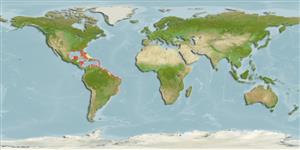Environment: milieu / climate zone / Tiefenbereich / distribution range
Ökologie
seewasser; süßwasser; brackwasser riff-verbunden; amphidrom (Ref. 46888). Tropical; 11°C - 31°C (Ref. 97140); 37°N - 33°S
Western Atlantic: USA (southern New Jersey, rarely taken above North Carolina) and Bermuda to southern Brazil.
Size / Gewicht / Alter
Geschlechtsreife: Lm ? range ? - ? cm
Max length : 7.5 cm TL Männchen/unbestimmt; (Ref. 7251); common length : 4.0 cm TL Männchen/unbestimmt; (Ref. 12193)
Rückenflossenstacheln (insgesamt) : 6 - 7; Rückenflossenweichstrahlen (insgesamt) : 10 - 12; Afterflossenstacheln: 0; Afterflossenweichstrahlen: 11 - 13. About 5 round or elongate dark blotches along mid-side, some with diagonal marks extending upward to form V shapes (Ref. 26938).
Body shape (shape guide): elongated.
Facultative air-breathing in the genus (Ref. 126274); Euryhaline species, ranging from brackish water (almost entering fresh water) to hypersaline littoral lagoons (Ref. 13628), with a salinity range of 0.0 to 25.9 ppt (Ref. 97140). Found in quiet waters of bays and estuaries, in grassy and muddy areas.
Life cycle and mating behavior
Geschlechtsreife | Fortpflanzung | Ablaichen | Eier | Fecundity | Larven
Benthic spawner.
Robins, C.R. and G.C. Ray, 1986. A field guide to Atlantic coast fishes of North America. Houghton Mifflin Company, Boston, U.S.A. 354 p. (Ref. 7251)
IUCN Rote Liste Status (Ref. 130435: Version 2025-1)
Bedrohung für Menschen
Harmless
Nutzung durch Menschen
Tools
Zusatzinformationen
Download XML
Internet Quellen
Estimates based on models
Preferred temperature (Ref.
123201): 23.3 - 28.1, mean 27.1 °C (based on 764 cells).
Phylogenetic diversity index (Ref.
82804): PD
50 = 0.5000 [Uniqueness, from 0.5 = low to 2.0 = high].
Bayesian length-weight: a=0.00661 (0.00419 - 0.01042), b=3.03 (2.90 - 3.16), in cm total length, based on LWR estimates for this species & (Sub)family-body (Ref.
93245).
Trophic level (Ref.
69278): 3.3 ±0.44 se; based on food items.
Widerstandsfähigkeit (Ref.
120179): hoch, Verdopplung der Population dauert weniger als 15 Monate. (Preliminary K or Fecundity.).
Fishing Vulnerability (Ref.
59153): Low vulnerability (10 of 100).
🛈
Nutrients (Ref.
124155): Calcium = 144 [75, 312] mg/100g; Iron = 0.905 [0.440, 1.683] mg/100g; Protein = 18.7 [16.8, 20.3] %; Omega3 = 0.17 [0.07, 0.32] g/100g; Selenium = 20.8 [9.8, 50.5] μg/100g; VitaminA = 128 [35, 438] μg/100g; Zinc = 2.51 [1.66, 3.68] mg/100g (wet weight);
